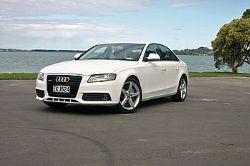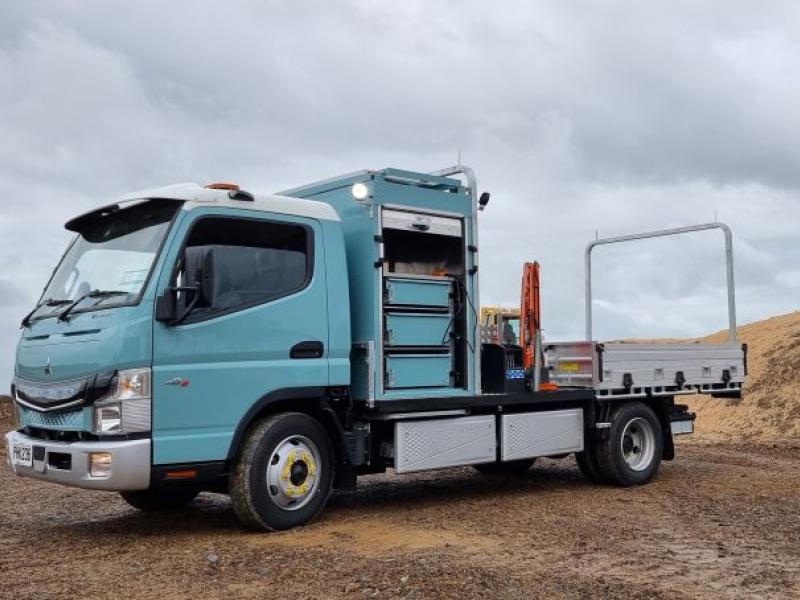Thanks to engineering innovations such as Audi Drive Select and Audi Dynamic Steering, the new fifth generation range of A4 sedans offers more driver orientated technology than ever before. With 8 million A4 owners worldwide, the Ingolstadt based manufacturer has sunk millions of deutschmarks into creating a whole new car from end to end to meet their customers’ expectations. Here in New Zealand the A4 accounts for 30 to 40 percent of total Audi sales in New Zealand, so the fact that the new model is roomier inside, has more powerful yet more fuel efficient engines and offers more options, is music to the ears of the importer. Audi NZ Managing Director Glyn Tulloch says that they expect the September arrival of the A4 Avant estate to account for 50 percent of total A4 sales; and its specification will mirror its sedan siblings. The New Zealand A4 sedan line up includes the 1.8T-FSI from $67,900, the 2.0 TDI from $68,900, the 2.7 V6 TDI from $78,900 and the 3.2 V6 FSI Quattro from $102,900, which means that there’s an A4 flavour to suit all buyer needs. The even more sports orientated S-Line specification adds another six to seven thousand dollars per car depending on which A4 model variant you choose. You may have noticed that unlike the previous A4 generation, this current range doesn’t offer as many quattro all-wheel-drive variants. The reason is quite simple; this is because the new multitronic Continuously Variable Transmission (CVT) is not yet compatible with Audi’s quattro all-wheel-drive system. They haven’t said so as yet, but you can bet the transmission boffins in Germany are working on it. Technological Innovations With a drag coefficient of 0.27, the new A4 sedan cuts its way through the wind with ease, and its 480-litre boot is larger than that of any of its direct competitors. It will give the recently launched C-Class Mercedes-Benz and the evergreen BMW 3 series some stiff competition in a discerning user-chooser market place. A major strength of the new saloon model bearing the four-ring badge is its low weight, which adds to the pleasure of the sporty driver and also reduces fuel consumption. The A4 1.8 TFSI tips the scales at just 1410 kilograms; the figure for the 2.0 TDI is 1460 kg. Iron and steel account for 32.0 percent of the total weight, closely followed by aluminium and magnesium at 31.7 percent. The low weight is also explained by the fact that the steel body shell is exceptionally light: although it is almost twelve cm longer and more than five cm wider than the previous model, it weighs about ten percent less. This was an ambitious target that Audi’s engineers solved by a total redesign of the body shell, starting from scratch on a clean computer screen. A further factor in the new Audi A4’s excellent balance is the relocation of the battery to the lower level of the boot. On both front-wheel-drive and quattro cars, the boot holds 480 litres, a volume that also puts the new A4 in the lead among its direct competitors. Thanks to a loading lip that is only 673 mm from the ground, the low step when loading, the straight side walls and flat floor, the boot of the new A4 can be utilised in a most practical way. It is lined with high-quality carpet and, with a loading width of 1000 mm throughout and a length of 1067 mm, can easily accommodate two golf bags placed sideways. Headroom at the front and rear seats has also gone up by a few mm, though there is still ample space between the seat occupants’ heads and the roof lining. At the rear of this five-seater, even heavily built passengers will appreciate the freedom of movement that Audi has provided. Legroom is now 908 mm, a useful 29 mm more than before and a figure worthy of a car in the large luxury class. The rear seats, with their slight individual contouring, are also notable for sporty comfort: the seat cushions are soft but the side sections slightly firmer; there is plenty of space for the occupant’s feet under the front seat. Thanks to the length of the doors and the wide angle to which they open, the rear seats can be reached and exited in comfort. The cup holders recessed into the door pockets can even hold large one-litre bottles. The rear foot wells are illuminated, and a fold-out centre armrest provides extra comfort. Optional extras include an electric rear-window roller blind and manually operated blinds for the rear side windows. Many welcome features have been provided for the front seat occupants. In addition to the cup holders in the large door pockets, there are two more cup holders of different sizes on the centre tunnel, a holder for sunglasses in the interior light module in the roof lining, a parking ticket clip on the sun visor and an unusually large glove box. An optional storage package includes a cup holder in the rear armrest, two compartments under the front seats and nets on the front-seat backs. A luxury extra for the front seats is a centre armrest that can be moved forward and back and varied in height. It includes a storage compartment and two useful 12V power sockets, and takes the place of the open tray on the tunnel. As a further option, the rear socket can be changed for one with a 230V output (110V in certain countries). 12-millimetre thick foam padding gives the centre armrest a pleasantly soft surface. This entire element is of such generous size because the new Audi A4 has an electromechanical parking brake, so that no space is needed for the conventional handbrake lever. Installed low down and of ample dimensions, the front seats integrate the driver and passenger perfectly into the car’s sporty ambience. Occupants of every size and stature feel immediately safe. Thanks to their ergonomic contours and upholstery, they support the occupant’s body perfectly. Body mountings of complex design and the high quality of the foam upholstery filter out any vibration caused by the road surface. Height adjustment is a standard feature of these seats, and their head restraints can be pulled well up if necessary. Among the many new A4 features that bring more than a hint of the luxury class with them is the boot lid opening system. There are three ways of gaining access to the boot: by radio-operated remote control, by pressing a button on the driver’s door or by touching the electrical switch in the handle recess. Any of these causes the lid to swing up automatically on its innovative hinged arms. Closure remains manual but needs very little physical effort. The rear seat backs have been arranged to fold down, a useful feature for those who require flexibility and who have to transport bulky loads. The seat back catches can be released by handles from inside the car and folded down on to the seat cushions without the head restraints having to be removed. In this way, the luggage capacity is increased to 962 litres. Another optional extra is a load-through hatch complete with removable ski bag. The new A4 is one of the very first cars to comply with all the new Japanese and European regulations concerning collisions with pedestrians. Foam material ahead of the bumper cross-member, ample deformation space and sheet-metal zone designed to deform effectively are among the specific features, together with special front-wing mountings designed to yield on impact. The most frequent accidents, fortunately, are the more harmless ones: light front-to-rear contact or minor bumps when parking the car. In the standard insurance-category crash test, with the car striking a barrier at 15 km/h and 40 percent overlap, the aluminium front cross-member with its mountings keeps damage low. The radiator and oil cooler remain intact, another reason for this being that a programmed breakaway point enables them to move back by 20 mm. In another standard insurance-category test, the rear bumper moves down and prevents damage to the sheet-metal body panels. In neither of these tests does the body structure suffer any damage. The bumpers are bolted to the body and can be replaced at only moderate effort and expense. They make contact with the adjacent side panels at accurately matched zero-gap joint lines. To achieve this, the engineers have used special reamed bolts and quick-release fasteners. Here too, Audi’s quality principles can be seen – and felt. Driving Impressions We set off from Auckland to the launch venue in the new 2.7 V6 TDI with the eight speed multitronic CVT which is also utilised in the 1.8T and the 2.0TDI. The multitronic CVT doesn’t have gears per se but a drive belt that is continuously variable, responding to throttle inputs from the driver changing up and down as necessary. Those eight “gears” in the multitronic are in actual fact not “gears” at all despite the fact that one has been selected manually by the driver. What actually happens is the electronic engine management system tells the CVT to shorten or lengthen its drive belts to create engine braking and thereby give the driver the feeling of shifting down a gear. The ability to manually change down eight “gears” might seem excessive but it gave all three of these particular models the ability to use engine braking rather than the driver’s right foot for reducing speed before a downhill corner. The 2.7 V6 TDI particularly impressed me with its blend of diesel performance, ride comfort, and handling. Despite having a large heavy engine over the front wheels, the body roll and under-steer are minimal in this model and the car certainly inspires confidence when attacking a corner. There’s a six-speed tiptronic gearbox in the flagship A4 3.2 V6 FSI as well as the quattro permanent four-wheel drive with a 40:60 torque spit. This set up gives the car a bias towards the rear wheels and the handling and power delivery are similar to a rear-wheel-drive saloon, especially when the car is fitted with Audi Drive Select, and dynamic mode is switched on. The Audi drive select control system allows the driver to adjust the operating characteristics of the engine, automatic transmission, steering and adaptive damping to suit his or her own preferences. There’s a choice of “Comfort” “Auto” and “Dynamic” modes which gives the A4 driver the ability to have three cars in one. Comfort is ideal for long motorway cruising, Auto is the best choice for urban drivers, and Dynamic mode is best utilised on a winding country road where the driver wants to experience the superb new chassis underneath. Another optional extra, Audi dynamic steering, operates with a superimposed gear system that varies the effective steering ratio according to road speed. At slower speeds, when turning sharp corners or parking, full lock will be reached with less than one turn of the steering wheel. While at higher speeds, the steering is much less sensitive. Additionally, close to the handling limits, it acts together with the ESP to stabilise the vehicle by slight but very rapid adjustments to the steering. In this way, the system combines responsive driving with a high level of safety. Normally we are quite dismissive of electronic drive train gadgetry but after experiencing both systems during a long cross country trip with the 3.2 V6 quattro, we came away impressed that Audi has delivered two optional extras that a discerning driver would be happy to pay money for. It does indeed add value to the A4 experience.
New Audi A4
Vehicle Fitout
Thursday, 05 June 2008
File Download:






